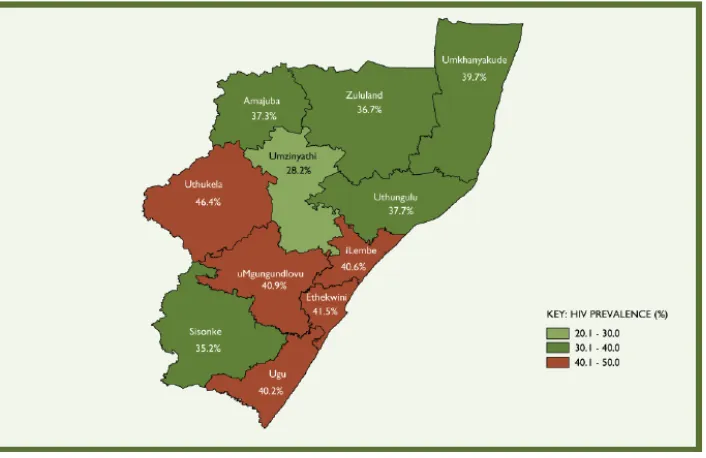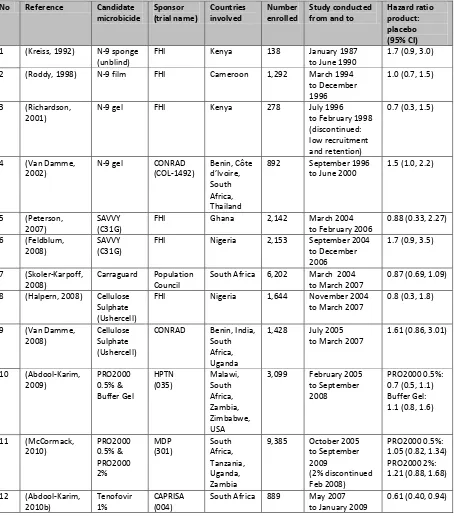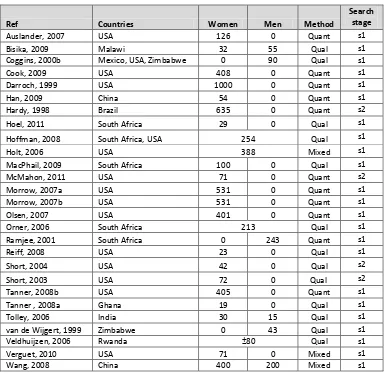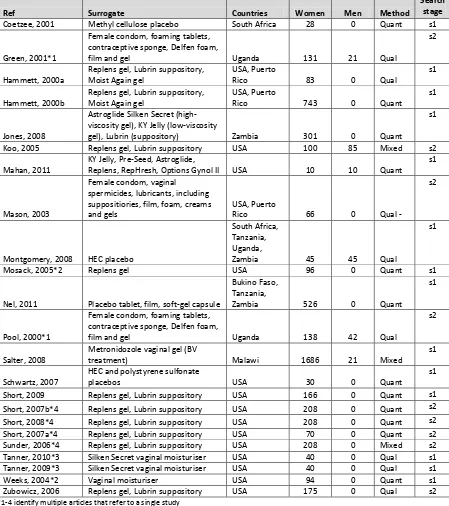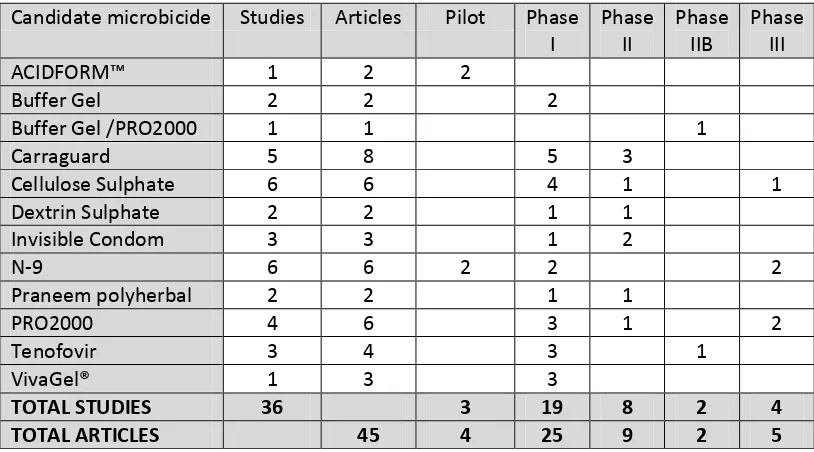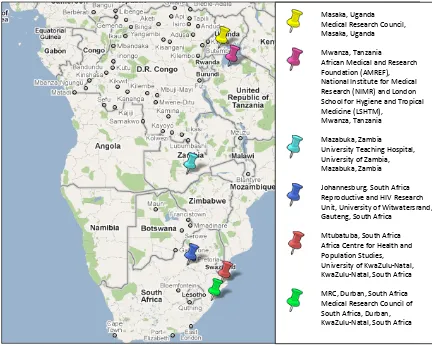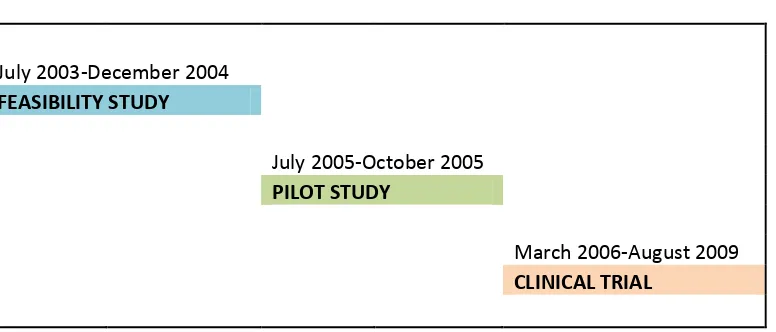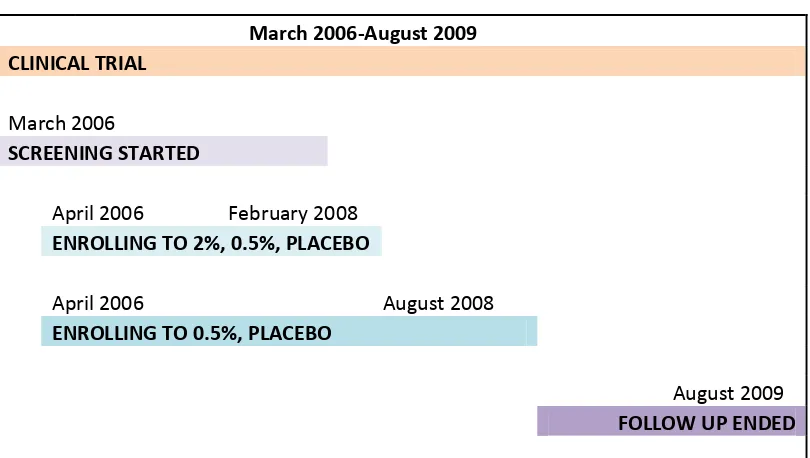City, University of London Institutional Repository
Citation
:
Gafos, Mitzy (2013). Microbicides, sexuality and sexual health in KwaZulu-Natal, South Africa. (Unpublished Doctoral thesis, City University London)This is the unspecified version of the paper.
This version of the publication may differ from the final published
version.
Permanent repository link:
http://openaccess.city.ac.uk/2987/Link to published version
:
Copyright and reuse:
City Research Online aims to make research
outputs of City, University of London available to a wider audience.
Copyright and Moral Rights remain with the author(s) and/or copyright
holders. URLs from City Research Online may be freely distributed and
linked to.
1
Microbicides, sexuality and sexual health in
KwaZulu-Natal, South Africa
Mitzy Gafos
Thesis submitted for Doctor of Philosophy (PhD)
City University London
School of Health Sciences
Volume 1 & 2
2
Contents of volume 1
Tables ... 11
Figures ... 13
Acknowledgements ... 14
Declaration ... 15
Abstract ... 16
Abbreviations ... 17
1 Introduction ... 19
1.1 HIV in South Africa ... 19
1.1.1 Political context ... 19
1.1.2 HIV prevalence ... 20
1.1.3 HIV incidence ... 22
1.2 Social drivers of HIV infection in KwaZulu-Natal... 22
1.2.1 Poverty ... 23
1.2.2 Migration ... 23
1.2.3 Relationship structures ... 24
1.2.4 Gender based violence ... 25
1.3 HIV and sexuality ... 25
1.4 HIV prevention in South Africa ... 26
1.4.1 HIV knowledge and testing ... 26
1.4.2 Abstinence ... 26
1.4.3 Being faithful ... 27
1.4.4 Condoms ... 27
3
1.5 New HIV prevention technologies ... 28
1.5.1 Vaccines ... 28
1.5.2 Antiretroviral therapy as pre-exposure prophylaxis ... 29
1.5.3 Microbicides ... 30
1.6 The context ... 31
1.7 This thesis ... 31
2 Literature review ... 35
2.1 Microbicide clinical research ... 35
2.1.1 First generation microbicides... 36
2.1.2 Second generation microbicides ... 40
2.2 Microbicide acceptability research ... 42
2.2.1 Hypothetical studies ... 43
2.2.2 Surrogate studies ... 45
2.2.3 Candidate microbicides ... 47
2.3 Compatibility as a measure of acceptability ... 57
3 Background to MDP 301 ... 61
3.1 Microbicides Development Programme ... 61
3.1.1 The Africa Centre for Health and Population Studies ... 62
3.1.2 Feasibility and pilot studies ... 63
3.2 MDP 301 study design ... 64
3.2.1 Intervention ... 64
3.2.2 Randomization ... 65
4
3.3 Study population and recruitment ... 66
3.3.1 Trial cohort ... 68
3.3.2 Trial in-depth interviews (IDIs) ... 70
3.3.3 Male partner in-depth interviews (IDIs) ... 71
3.3.4 Trial focus group discussions (FGDs) ... 72
3.3.5 Community focus group discussions (FGDs) ... 72
3.4 Data collection ... 73
3.4.1 Trial cohort ... 73
3.4.2 Trial IDIs... 74
3.4.3 Male partner IDIs ... 75
3.4.4 Trial FGDs ... 75
3.4.5 Community FGDs ... 76
3.4.6 Quantitative data ... 76
3.5 Data management ... 76
3.5.1 Qualitative data ... 76
3.5.2 Quantitative data ... 77
3.6 Ethical issues ... 78
3.6.1 Informed consent ... 78
3.6.2 Standard of care and prevention ... 79
3.6.3 Ethical review ... 80
3.7 My role in MDP 301 ... 81
4 Methods ... 83
5
4.1.1 Defining ‘Culture’ ... 83
4.1.2 Socio-cultural anthropology ... 83
4.1.3 Conceptual inventory ... 84
4.2 Mixed methods ... 86
4.2.1 Mixed methods research ... 86
4.2.2 Mixed methods: MDP 301 trial ... 87
4.2.3 Mixed methods: PhD ... 88
4.3 A critical reflection on my methodology... 90
4.3.1 Mixed qualitative methods ... 90
4.3.2 Mixed qualitative and quantitative methods ... 92
4.3.3 Working with translated data ... 93
4.4 Qualitative data... 96
4.4.1 Qualitative data preparation ... 96
4.4.2 Qualitative data analysis ... 97
4.4.3 Analytical considerations ... 100
4.5 Quantitative data ... 102
4.5.1 Demographic and socio-economic variables ... 102
4.5.2 Sexual behaviour variables ... 104
4.5.3 Trial participant variables ... 107
4.5.4 Quantitative data analysis... 107
4.6 Conclusion ... 107
5 Intravaginal cleansing in KwaZulu-Natal ... 109
6
5.1.1 Intravaginal cleansing ... 109
5.1.2 Prevalence of intravaginal cleansing ... 112
5.1.3 Motivation for intravaginal cleansing ... 116
5.1.4 Intravaginal cleansing as part of vaginal hygiene ... 118
5.1.5 Intravaginal practices and HIV acquisition ... 122
5.1.6 Intravaginal cleansing and microbicides ... 123
5.2 Methods ... 125
5.2.1 Instructions regarding intravaginal cleansing ... 125
5.2.2 Quantitative data ... 126
5.2.3 Qualitative data ... 128
5.3 Results – quantitative analysis ... 128
5.3.1 Univariate analysis ... 128
5.3.2 Multivariate analysis ... 132
5.3.3 Changes over time ... 133
5.4 Results – qualitative analysis of community FGDs... 134
5.4.1 Motivation ... 134
5.4.2 Classification ... 135
5.4.3 Implication ... 136
5.5 Results – qualitative analysis of trial IDIs ... 137
5.5.1 Intravaginal cleansing ... 137
5.5.2 Microbicide gel use ... 138
5.5.3 Factors that influence intravaginal cleansing ... 139
7
5.6.1 Prevalence and factors associated with intravaginal cleansing ... 141
5.6.2 Intravaginal cleansing when using microbicide gel... 144
5.6.3 Changing intravaginal cleansing practices ... 146
5.7 Conclusion ... 147
6 Intravaginal insertion in KwaZulu-Natal ... 149
6.1 Literature review ... 149
6.1.1 Prevalence of intravaginal insertion ... 151
6.1.2 Motivation for intravaginal insertion ... 153
6.1.3 Intravaginal insertion as part of sexual preparation ... 153
6.1.4 Intravaginal insertion and microbicides ... 155
6.2 Methods ... 156
6.3 Results ... 157
6.3.1 Intravaginal insertion ... 157
6.3.2 Microbicide gel ... 162
6.3.3 Social acceptability ... 165
6.3.4 Sexual pleasure ... 166
6.4 Discussion ... 168
6.5 Conclusion ... 171
7 ‘The things we do for love’: Love medicines ... 173
7.1 Literature review ... 173
7.1.1 Zulu cosmology ... 175
7.1.2 Traditional health practitioners in South Africa ... 175
8
7.1.4 Types of love medicines ... 178
7.1.5 Love medicines and microbicides ... 180
7.2 Methods ... 181
7.3 Results ... 182
7.3.1 Love ... 182
7.3.2 Love medicines ... 183
7.3.3 Microbicides ... 188
7.4 Discussion ... 192
7.5 Conclusion ... 197
8 ‘What have men got to do with it’: discussing microbicides with male partners ... 199
8.1 Literature review ... 199
8.1.1 Discussing microbicides ... 199
8.1.2 Expectations regarding communication about microbicides ... 201
8.1.3 Communicating about the use of microbicides ... 203
8.1.4 Sexual communication and microbicides ... 205
8.1.5 Terminology ... 206
8.2 Methods ... 207
8.2.1 Quantitative data ... 207
8.2.2 Qualitative data ... 209
8.3 Results – quantitative analysis ... 210
8.3.1 Univariate analysis ... 210
8.3.2 Multivariate analysis ... 213
9
8.4.1 Sexual communication ... 215
8.4.2 Communication about microbicides ... 217
8.4.3 Use of microbicides without a partners knowledge ... 218
8.4.4 Relationship issues ... 219
8.5 Results – qualitative analysis of trial IDIs ... 220
8.5.1 Talking about sex ... 220
8.5.2 Talking about microbicides ... 220
8.5.3 Using microbicide gel without prior discussion ... 227
8.6 Discussion ... 229
8.6.1 Cultural norms relating to sexual communication ... 230
8.6.2 Discussing microbicides ... 230
8.6.3 Not discussing microbicides ... 232
8.6.4 Female used or female controlled? ... 234
8.6.5 Power dynamics ... 235
8.6.6 Supporting women to discuss microbicides ... 236
8.7 Conclusion ... 236
9 Discussion ... 239
9.1 Compatibility of microbicides and socio-cultural norms ... 239
9.2 New findings ... 240
9.3 Implications for research ... 241
9.3.1 Data collection ... 242
9.3.2 Adherence ... 243
10
9.3.4 Sex during menstruation ... 244
9.4 Implications for service delivery ... 244
9.4.1 Marketing ... 245
9.4.2 Point of access... 245
9.4.3 Counselling ... 246
9.4.4 Public health messages about intravaginal practices and HIV ... 246
9.5 Repositioning sexual pleasure ... 247
9.6 Reconsidering gender (in)equality ... 248
9.7 Limitations... 249
9.8 Conclusion ... 250
11
Tables
Table 2-1: Randomised control trials which have evaluated the safety and effectiveness of
candidate microbicides ... 37
Table 2-2: Hypothetical studies ... 44
Table 2-3: Surrogate studies ... 46
Table 2-4: Number of studies and related manuscripts included in the systematic literature review of candidate microbicide acceptability ... 48
Table 2-5: Systematic literature review extraction table ... 50
Table 3-1: Trial cohort – number of women screened and enrolled ... 70
Table 3-2: Trial IDIs ... 71
Table 3-3: Number of IDIs and FGDs ... 73
Table 4-1: Individual demographic variables ... 103
Table 4-2: Household demographic and socio-economic variables ... 104
Table 4-3: Sexual behaviour variables ... 105
Table 4-4: Sexual behaviour variables based on per sex act data ... 106
Table 5-1: Classification of vaginal practices in the World Health Organization Gender, Sexuality and Vaginal Practices study ... 110
Table 5-2: Systematic literature review of intravaginal cleansing in Africa ... 111
Table 5-3: Microbicide trials reporting of intravaginal cleansing ... 124
Table 5-4: Individual and household characteristics of women who intravaginally cleansed up to one hour after sex compared to women who did not ... 130
Table 5-5: Sexual behaviour characteristics of women who intravaginally cleansed up to one hour after sex compared to women who did not ... 131
12
Table 5-7: Multivariate model comparing women who intravaginal cleansed up to one hour
after sex compared to women who did not ... 133
Table 6-1: Systematic literature review of intravaginal insertion in Africa ... 150
Table 6-2: Description of the IDI sample... 157
Table 6-3: Description of the FGD sample ... 157
Table 7-1: Literature on love medicines within the systematic literature review of vaginal practices in Sub-Saharan Africa ... 175
Table 8-1: Systematic literature review extraction table: discussing microbicides ... 200
Table 8-2: Proportion of women who discussed microbicides with their partners/clients ... 204
Table 8-3: Individual characteristics of women who discussed gel use with their partner compared to women who did not discuss gel use at week 4 ... 211
Table 8-4: Household characteristics of women who discussed gel use with their partner compared to women who did not discuss gel use at week 4 ... 212
Table 8-5: Sexual behaviour characteristics of women who discussed gel use with their partner compared to women who did not discuss gel use at week 4 ... 213
13
Figures
Figure 1-1: Map of South Africa showing HIV prevalence in the 9 provinces in 2008 ... 20
Figure 1-2: HIV prevalence distribution among antenatal women by district in KwaZulu-Natal, 2009 ... 21
Figure 3-1: MDP 301 clinical trial research institutions ... 62
Figure 3-2: Timelines of Africa Centre MDP studies ... 63
Figure 3-3: Gel applicator ... 64
Figure 3-4: Timelines of MDP 301 ... 65
Figure 3-5: Map of South Africa showing the 9 provinces and 52 districts ... 66
Figure 3-6: Map of Hlabisa health sub-district ... 67
Figure 3-7: MDP 301 study groups... 68
Figure 3-8: Summary of visit schedule for MDP 301 trial participants ... 74
Figure 5-1: Prevalence of intravaginal cleansing in Africa as reported in the literature ... 113
Figure 5-2: Vaginal practices contextualised ... 118
Figure 5-3: The how, what and when of intravaginal cleansing ... 119
Figure 5-4: Participant information visual flipchart: gel application instructions ... 125
Figure 6-1: Prevalence of intravaginal insertion in Africa as reported in the literature ... 152
Figure 6-2: Intravaginal insertions ... 159
14
Acknowledgements
First and foremost I want to thank the Africa Centre MDP 301 trial participants, without whom
this thesis would not have been possible. Secondly I need to thank the Africa Centre MDP 301
staff members for their commitment and dedication. I am particularly grateful to Misiwe
Mzimela and Hlengiwe Ndlovu for their support every step of the way!
I want to recognise the memory of five staff members who died during the Africa Centre
Microbicide Study, as their passing constantly reminds me of the urgent need for additional
HIV prevention options in KwaZulu-Natal: Bonisiwe Mfekayi, Rachel Gina, Derrick Xulu, Thobile
Ndaba and Manini Ngwenya.
I thank the partners of the trial participants who agreed to be interviewed and the community
members who participated in focus group discussions. I am indebted to the Africa Centre CAB
members, other stakeholder organizations and, more generally, the people of Umkhanyakude,
for their support. There are too many names to mention the friends and colleagues at the
Africa Centre over the years that were an invaluable source of strength and laughter.
I want to acknowledge all members of the Microbicides Development Programme from whom
I learnt so much during the course of the trial – and especially Sheena McCormack for her
unwavering faith in my ability to manage the trial and complete this PhD.
I have appreciated all the support, guidance and patience from my supervisors, Jonathan
Elford and Robert Pool. Thank you to the many friends and colleagues who kindly reviewed
sections of this thesis: Tom Heller, Claudia Wallrauch, Sarah Joseph, Angela Crook, Molly
Fitzgerald, Fiona Scorgie, Anette Wickström and Catherine Montgomery.
Last but definitely not least, I want to thank my mum (Anna) and Ronald, for all their belief in
me and for putting up with the physical and emotional ups and downs of both the trial and the
15
Declaration
I, Mitzy Gafos, confirm that the work presented in this thesis is my own.
I hereby grant powers of discretion to the University Librarian to allow the thesis to be copied
in whole or in part without further reference to the author. This permission covers only single
copies made for study purposes, subject to normal conditions of acknowledgement.
16
Abstract
There is an urgent need for additional HIV prevention options for women. Evidence supporting the benefit of microbicides in reducing the risk of vaginally acquired HIV acquisition has provided a major breakthrough. Despite the wealth of evidence supporting microbicide acceptability in Africa, there are still gaps in our understanding about how women will incorporate microbicides into their everyday lives.
In this thesis I examine whether vaginal microbicides are compatible with socio-cultural norms regarding sexuality and sexual health in a predominantly rural area of KwaZulu-Natal, South Africa. Using qualitative and quantitative data collected as part of the MDP 301 clinical trial at the Africa Centre, I adopt a mixed methods approach to evaluate microbicide acceptability from a cultural perspective. I explore the compatibility of microbicides with socio-cultural norms that relate to intravaginal cleansing, intravaginal insertion, love medicines and sexual communication.
I found that the desired effects of using intravaginal insertions to enhance sexual pleasure are compatible with the experiences of using microbicides; that contemporary socio-cultural norms relating to sexual communication in the context of the HIV epidemic are compatible with the introduction of microbicides; that women distanced microbicides from ‘love medicines’ in terms of separating microbicides from the supernatural; and, finally, that post-coital intravaginal cleansing practices could undermine a microbicides roll out programme if we fail to address these practices.
17
Abbreviations
ABC Abstain, be faithful, condomize
ACASI Audio computer-assisted self-interview
Africa Centre Africa Centre for Health and Population Studies AIDS Acquired immune deficiency syndrome
ANC African National Congress
ARV Antiretroviral
AVAC AIDS vaccine advocacy coalition BAT24 Before-after-two-24
BV Bacterial vaginosis
CAB Community advisory board
CAPRISA Centre for the AIDS Programme of Research in South Africa CAR Central African Republic
CASI Computer-assisted self-interview
CD Coital diary
CD4 Cluster of differentiation 4 CDC Centers for Disease Control
CI Confidence interval
CONRAD Contraceptive Research And Development Program
CRF Case report form
CS Cellulose sulfate
CT Chlamydia trachomatis
DFID Department for International Development DRC Democratic Republic of Congo
DSMB Data and safety monitoring board
FACTS Follow-on African Consortium for Tenofovir Studies FAQ Frequently asked questions
FDA Food and Drug Administration
FGD Focus group discussion
FHI Family Health International
FSW Female sex worker
FTC Emtricitabine
GCLP Good clinical laboratory practice GCP Good clinical practice
GPP Good pharmacy practice
GSVP Gender, sexuality and vaginal practices HEC Hydroxyethylcellulose (placebo)
HIV Human immunodeficiency virus
HPTN HIV Prevention Trials Network (subsequently MTN) HSV2 Herpes simplex virus 2
IVC Intravaginal cleansing
IDI In-depth interview
IPM International Partnership for Microbicides iPrEX Pre-Exposure Prophylaxis Initiative
KZN KwaZulu-Natal
18 MCC Medicines Control Council
MDP Microbicides Development Programme
MRC Medical Research Council
MSM Men who have sex with men
MTCT Mother-to-child-transmission
MTN Microbicide Trials Network
OR Odds ratio
N-9 Nonoxynol-9
NG Neisseria gonorrhoea
NIH National Institutes of Health
NRTI Nucleotide reverse transcriptase inhibitor NSP National strategic plan
PEP Post exposure prophylaxis PIS Participant information sheet
PO Participant observation
PrEP Pre-exposure prophylaxis S1 Stage 1 literature review S2 Stage 2 literature review
SA South Africa
SOP Standard operating procedure STI Sexually transmitted infections TDF Tenofovir disoproxil fumarate
TV Trichomonas vaginalis
UK United Kingdom
UNAIDS Joint United Nations Programme on HIV/AIDS USA United States of America
VOICE Vaginal and oral interventions to control the epidemic
19
1
Introduction
Summary
In this thesis I investigate the interface between microbicides, sexuality and sexual health in
KwaZulu-Natal, South Africa. This chapter will serve as an introduction to these topics. I start
by mapping the epidemiology of the Human Immunodeficiency Virus (HIV) in South Africa from
the start of the epidemic to the present day. I continue by outlining the role that gender
inequality plays as a social driver of the epidemic in KwaZulu-Natal. I also discuss female
sexuality in South Africa and the extent to which positive images of sexuality have been
marginalised in HIV discourse. I proceed by describing the existing HIV prevention options
available in South Africa and discuss the limitations, for women, of prevention messages that
focus on abstinence, being faithful, condoms and circumcision. Next, I explain the potential
new HIV prevention technologies, including vaccines, pre-exposure prophylaxis and
microbicides. I argue that in preparation for the implementation of microbicides, we need to
understand more about the ways in which socio-cultural norms might facilitate or impede the
use of new prevention technologies. Finally I summarise the main objectives of this thesis.
1.1
HIV in South Africa
1.1.1
Political context
South Africa was slow to respond to HIV when it first emerged in the early 1980’s. During the
political instability of the late 1980’s and early 1990’s, both the ruling apartheid National Party
and the exiled African National Congress (ANC) promoted mis-information and conspiracy
theories about HIV and the acquired immunodeficiency syndrome (AIDS) (Susser, 2009). In
1990 when ANC leaders and other anti-apartheid activists released their first collective
statement on HIV and AIDS in Southern Africa, less than 1% of women attending antenatal
clinics were HIV positive (DoH, 2010). When the ANC were elected as the first democratic
government of South Africa in 1994, HIV prevalence among antenatal clinic attendees had
increased eight fold. Despite this, implementation of the first National AIDS Strategy was
overshadowed by the demands of political transition to a non-racial democracy. When the
second democratically elected president of South Africa took post in 1999, HIV prevalence
among women attending antenatal clinics had risen to over 22%. The optimism generated by
the release of the first National Strategic Plan (2000 to 2005) soon dissipated as South Africa’s
response to HIV was paralysed by AIDS denialism. In 2002, when the South African government
lost a yearlong fight in the High Court and Constitutional Court trying to defend their decision
20
antenatal clinics were HIV positive (Coovadia, 2009). By the time the South African
government finally started rolling out antiretroviral drugs in 2004, HIV prevalence in antenatal
clinics had reached 30%.
The period of AIDS denialism left many South Africans confused about the cause of HIV, the
association between HIV and AIDS, and the safety of antiretroviral drugs (Robins, 2005).
Accurate information about HIV prevention and treatment was undermined by government
leaders who legitimized myths such as the preventive benefit of showering after sex and the
treatment benefits of garlic, olive oil, lemon and beetroot (McGregor, 2009). Given this history,
it is perhaps no surprise that in 2009 South Africa had more people living with HIV than any
other country in the world. An estimated 5.6 million South Africans were HIV positive, which
was equivalent to 11% of the total population (UNAIDS, 2010).
1.1.2
HIV prevalence
The distribution of HIV in South Africa is by no means uniform. Racial classification in South
Africa is divided into 4 groups representing 11 official language groups; Black African,
Coloured, Indian or Asian, and White (Erasmus, 2008). HIV affects Black Africans more than any
other racial group in South Africa. The 2008 national survey of everyone aged 2 years old or
above reported 14% prevalence among Black Africans, compared to 1.7% among Coloured
[image:21.595.112.476.484.750.2]women and men, and 0.3% each for White and Indian populations (Shisana, 2009).
21
Similarly, HIV prevalence varies dramatically across the 9 provinces in South Africa (Figure 1-1).
This thesis is based on research conducted in the province of KwaZulu-Natal, which has
reported the highest rates of HIV since sentinel surveillance commenced in 1990. While
national prevalence among everyone over the age of 2 years olds was almost 11% in 2008,
prevalence in KwaZulu-Natal was at almost 16% (Shisana, 2009).
HIV prevalence by district is only available for antenatal clinic attendees. KwaZulu-Natal
includes 11 districts (Figure 1-2). This thesis is based on research conducted in the
Umkhanyakude district of KwaZulu-Natal. In 2009 it reported the 6th highest prevalence from
[image:22.595.119.472.317.546.2]antenatal data in the KwaZulu-Natal province (39.7%).
Figure 1-2: HIV prevalence distribution among antenatal women by district in KwaZulu-Natal, 2009
The higher prevalence in antenatal clinics reflects the fact that the epidemic is at its peak in
women of reproductive age. Among all 15 to 49 year old South Africans, the female to male
infection ratio was approximately 1.5 to 1 for women compared to men in 2008 (Shisana,
2009). In the Umkhanyakude District just over half of all 25 to 29 year old women were living
with HIV in 2004 (Welz, 2007). HIV prevalence appears to have stabilised since then (Shisana,
2009, Rice, 2007). However, the combination of race, geographic location, sex and age,
continues to place Black African women of reproductive age living in KwaZulu-Natal at the
22
1.1.3
HIV incidence
By 2005, the South African Department of Health had implemented a comprehensive HIV
prevention and treatment programme. Despite this, HIV incidence has only declined among
women aged 15 to 24 years old which appears to correspond with a significant increase in
condom use among this age group (Shisana, 2009). In all other age groups HIV incidence has
remained stable (Rehle, 2010).
In the Umkhanyakude district of KwaZulu-Natal, between 2003 and 2007 HIV incidence among
15 to 49 year old women has been stable at around 3.8 per 100 person years (Bärnighausen,
2008a, Bärnighausen, 2009, Bärnighausen, 2008b). South Africa failed to achieve its goal of
reducing the national HIV incidence rate by 50% from 2007 to 2011 (NSP, 2007) and on the
basis of the available evidence, it is unlikely that it will meet this same target by 2016 (NSP,
2012). Bärnighausen concluded his evaluation of HIV incidence in Umkhanyakude by stating
that: “without a renewed emphasis on HIV prevention, it seems unlikely that the HIV epidemic
in rural South Africa will be conquered” (Bärnighausen, 2008a).
1.2
Social drivers of HIV infection in KwaZulu-Natal
There are a range of biological drivers that increase women’s risk of HIV acquisition in
KwaZulu-Natal, such as the high prevalence of other sexually transmitted infections (STIs).
Equally there are a range of social drivers that increase women’s susceptibility to HIV infection.
Social drivers refer to individual, social, cultural, and structural level factors that impede an
individuals’ ability to mitigate the risks of HIV acquisition (UNAIDS, 2007). Auerbach (aids2013
social drivers working group (2009;2)) explains that social drivers are “complex, fluid,
non-linear, and contextual, and they interact dynamically with biological, psychological, behavioral,
and other social factors”.
Social and cultural factors that influence HIV transmission are rooted in the historical, political
and economic context of South Africa. This context has resulted in the construction of
socio-cultural norms that place women in unequal relations to men. The unequal position of women
in relationships, families, societies and public domains creates and reinforces fundamental
vulnerabilities for women in terms of HIV. The ways in which gender inequalities impact on
the risk of HIV acquisition for women in Zulu society are multiple and complex. Socio-cultural
norms not only define gender relations, but also expectations regarding relationship dynamics,
marriage, fertility, monogamy, couples residency patterns and gender based violence
(Stockard, 2002). At an individual level gender inequality diminishes women’s ability to refuse
sex, to insist on mutual monogamy or to negotiate condom use. At a societal level gender
23
sexual partners for men, sex without a condom, alcohol abuse by men and tolerance toward
violence against women.
In this gender inequitable context, poverty, migration, relationship structures and gender
based violence present independent and overlapping challenges for women that increase their
vulnerability to HIV. Gender inequalities prevent many women from being able to implement
the behavioural changes necessary to reduce their risk of HIV acquisition. Whilst it is important
to minimise the impact of these socio-cultural drivers on women’s lives, future HIV prevention
options must offer women the potential to protect themselves from HIV even in the presence
of these socio-cultural realities.
1.2.1
Poverty
Approximately half of rural households in the Umkhanyakude district of KwaZulu-Natal are
defined as living below the poverty line (below $2 per person per day) (StatsSA, 2010). The
correlation between poverty and HIV is not clear cut in the Umkhanyakude district. In this
impoverished environment (Case, 2004), risk factors for HIV prevalence and incidence have
been both negatively (Bärnighausen, 2007, Tanser, 2009) and positively (Welz, 2007)
associated with indicators of relative poverty. However, poverty has the potential to increase
women’s vulnerability to HIV in a number of ways. Poverty increases the chances of women
entering into transactional sexual relationships (Lees, 2009). Poverty further exacerbates
power inequalities in relationships and increases women’s dependency on men for economic
security (Weiser, 2007, Varga, 1997, Pivnick, 1993). This in turn decreases the chance of
mitigating HIV related risk factors by diminishing some women’s ability to implement safer sex
practices or dissolve relationships. Poverty indicators have been linked to lower condom use
(Tladi, 2006), lower rates of contraceptive use (Subramanian, 2008), and higher rates of
concurrent partnerships (Mishra, 2009). Reducing poverty through microfinance initiatives has
been shown to reduce HIV related risk behaviours among women (Kim, 2009). For women,
living in poverty exacerbates their unequal relationship with men further hindering their ability
to mitigate the risk of HIV.
1.2.2
Migration
Almost a third of all household members spend the majority of their time away from the rural
household in the Umkhanyakude district (Muhwava, 2007). Migration is a well-established risk
factor for HIV for both women and men (Lurie, 2006). Men who migrate for work are over
twice as likely to have HIV (34%) than men who do not migrate (14%) (Welz, 2007). Women
who migrate are also more likely to be HIV positive (41%) than women who don’t (27%) (Welz,
24
relationships with labour migrants, reducing their bargaining power for safer sex options
(Hankins, 2006). Women with partners who migrate are also more likely to have additional
sexual partners (Lurie, 2003a). Women who migrate are more likely to enter into casual or
transactional relationships (Gay, 2010). Being in a relationship with a migrant labourer or being
a migrant labourer presents particular challenges to structures and patterns of sexual
relationships which increase the risk of exposure to HIV for women.
1.2.3
Relationship structures
Whilst non-marital sex is frowned upon in Zulu culture, Zulu traditional authorities lend
legitimacy to non-marital relationships, for example by defining familial responsibilities
relating to non-marital childbirth (Berglund, 1976). KwaZulu-Natal has unusually low rates of
marriage, high rates of non-marital child-birth, low rates of cohabitation among couples and
high rates of multiple partnerships compared to the rest of Africa (Bongaart, 2006, McGrath,
2009a, Camlin, 2004, Hosegood, 2009).
Marriage can have a protective effect for some women, by reducing the number of sexual
partners involved in the sexual network (Bongaart, 2006, Tanser, 2009, Welz, 2007,
Bärnighausen, 2008a). Conversely marriage can increase the risk of infection for other women,
by preventing women from being able to abstain from sex, reducing women’s ability to refuse
sex, increasing sexual frequency, and decreasing condom use (Clark, 2004, Hearst, 2004,
Green, 2003, Ahmed, 2001, Bessinger, 2003, Maharaj, 2005a, Lurie, 2003b, Ndinda, 2007,
Maharaj, 2005b, Camlin, 2003). In the province, unprotected sex among young unmarried
couples is common with the vast majority of first births being out of marriage to young women
at an average age of 19 years old (McGrath, 2009a, Camlin, 2004).
In Umkhanyakude, cohabitation is low among married and unmarried couples with a third of
men not permanently residing with their long-term female partner (Hosegood, 2009). This sits
alongside the fact that approximately a quarter of men report multiple or concurrent
partnerships (McGrath, 2009b). Multiple and concurrent partnerships increase the risk of HIV
infection for women and men (Lurie, 2003b). Concurrent relationships offer specific risks by
facilitating the swift spread of HIV across the sexual network in the period following
seroconversion, when infectivity is at its peak (Halperin, 2004, Mah, 2010, Halperin, 2007).
These socio-cultural patterns of relationship structures and fertility place many women in
KwaZulu-Natal at specific risk of HIV acquisition and undermine their ability to protect
25
1.2.4
Gender based violence
Gender based violence is an important aspect of gender inequality in South Africa (WHO,
2010). Socio-cultural norms define the extent to which women are blamed for violence by
men. Violence is viewed as a normal marker of masculinity and intimate partner violence is
tolerated and established as a taboo subject, limiting female victims’ ability to challenge it
(Ilika, 2005, Petersen, 2005, Fox, 2007). A recent review of the literature in South Africa
demonstrated that women’s relative disempowerment in relationships with men reduced their
ability to refuse sexual advances and negotiate safer sexual practices (Ncube, 2010). Attempts
to refuse sex or insist on safer sex can result in verbal, economic, psychological, physical or
sexual abuse (Ncube, 2010). For women who are economically dependent on their partners for
household security and stability, even the threat of abandonment can be sufficient to
discourage negotiations for safer sex. There is a strong correlation between both power
inequality in relationships and intimate partner violence, and HIV infection for women (Jewkes,
2010b).
A series of interventions have demonstrated the positive impact that reducing gender
inequality, economic dependency, and intimate partner violence can have on improving HIV
prevention and promoting safer sex practices (Jewkes, 2008, Hargreaves, 2010, Michau, 2008,
Barker, 2007). HIV prevention has to address gender inequality at multiple levels if it is to
change the social, cultural, economic and political drivers of the epidemic for women.
1.3
HIV and sexuality
I have outlined above that gender inequality is a major factor in the spread of HIV and in
preventing women from being able to mitigate the risks of HIV infection. However, gender
inequality is not a universal, immutable aspect of African women’s lives. HIV discourse has
tended to exclusively depict African women as passive victims of HIV made vulnerable due to
being ‘subjects’ of male domination through their socio-cultural and economic
disempowerment (Berger, 2004). This view ignores women’s enactment of agency,
self-determination and resistance to both male hegemony and HIV. Boyce argues that by
presenting a monolithic image of passive vulnerable African women, HIV discourse limits
women’s resistance and reifies the disempowerment of women in society (Boyce, 2007).
This view of African women as passive victims has hindered broader discussions about women
as sexual beings. By exclusively talking about sex in terms of ‘risk’ and ‘danger’, HIV discourse
has lost sight of the fact that African women enjoy sex for the sake of sex as much as other
women and men around the world (Berger, 2004). HIV discourse has taken a reductive view of
26
who sex is occurring with. Equally this discourse has reduced the sexual experiences of African
women to economic functionality, social responsibility, or passive acquiescence. Sex is about
more than just with whom, when and how an act of sex occurs. Sex is part of a much broader
meaning of sexuality which incorporates love, intimacy, passion and pleasure. The failure to
include women’s desire for sexual pleasure within the parameters of safer sex decision making
has meant that women are far more likely to be described as “not able” to use condoms than
“not willing” to. We need to consider female sexual pleasure and physical fulfilment within our
paradigm of HIV prevention if we are to develop options that meet women’s sexual needs as
well as their health needs.
New HIV prevention technologies need to be considered and positioned within a broader
interpretation of the multiple sexualities of African women and men, in order to meet their
diverse needs. HIV prevention has to find ways to mitigate the negative aspects of the social
drivers of the epidemic but within a discourse that also incorporates constructive views of
sexuality (Philpott, 2006b).
1.4
HIV prevention in South Africa
The reduction in HIV incidence among young women aged 15 to 24 years old (described above
in section 1.1.3) is an important achievement for HIV prevention in South Africa. However,
three decades into the epidemic, the information, education and communication behavioural
change strategies have failed to stem the epidemic among most of the adult population.
1.4.1
HIV knowledge and testing
Despite over 80% of the adult population being exposed to national HIV communication
programmes, in 2008 only about a third of women of reproductive age demonstrated correct
knowledge about HIV prevention and transmission (Shisana, 2009). Similarly, despite mass
promotion of HIV counselling and testing, only about half of women over 15 years of age had
ever had a HIV test. Less than a third of 15 to 49 year old women had tested and received their
results in the year before the survey. These national levels of knowledge and rates of testing
are disappointingly low, and were similar in KwaZulu-Natal.
1.4.2
Abstinence
Abstinence has been widely promoted in South Africa, as has delaying the age of sexual
initiation which has been shown to reduce the risk of HIV infection for young women (Pettifor,
2004b, Drain, 2004). In KwaZulu-Natal, the traditional practice of virginity testing has been
reintroduced (Leclerc-Madlala, 2001, Scorgie, 2002, Wickström, 2010). However, from 2002 to
27
(6%) who reported having their first sexual encounter before the age of 15 (Shisana, 2009).
Among 12 to 14 year olds, 11% of young men and 15% of young women had been sexually
active in the previous 12 months (Shisana, 2010). There is no evidence of a decline in the
median age of first sex among women in KwaZulu-Natal which remains around 18 years old
(McGrath, 2009a, Camlin, 2004).
1.4.3
Being faithful
Being faithful has been extensively promoted as an important HIV prevention strategy.
However, the over simplification of this message often misses the point that monogamy only
offers protection against HIV when it is exclusive and between partners confirmed to be HIV
negative. Nonetheless, there has been no decline in multiple partners among women or men
above 15 years old from 2002 to 2008 (Shisana, 2009). Young women are significantly less
likely than men to report multiple relationships (6% of women compared to 31% of men)
(Shisana, 2009) or concurrent relationships (1% of women compared to 28% of men)
(McGrath, 2009b). However, women are more likely to report intergenerational relationships
which have been associated with increased risk of HIV infection (Leclerc-Madlala, 2008,
Pettifor, 2005). The proportion of 15 to 19 year old women in a relationship with a partner 5 or
more years older, increased from 19% in 2005 to 28% in 2008 (Shisana, 2009).
1.4.4
Condoms
The correct and consistent use of male or female condoms remains the only available way to
prevent HIV infection during sex for both women and men at the same time. Reported condom
use at last sex increased significantly from 2002 to 2008 among women and men in all age
groups (Shisana, 2009). The national increases in condom use are mirrored in KwaZulu-Natal,
although condom use at last sex remains lower among 15 to 24 year old women than among
men in the same age group (Chimbindi, 2010). Despite impressive increases in reported
condom use at last sex, the lack of a decline in overall HIV incidence is generally attributed to
the challenges of using condoms consistently, especially in long-term relationships (Hearst,
2004, Maharaj, 2005a). In 2004 Hearst claimed that “no clear examples have emerged yet of a
country that has turned back a generalized epidemic primarily by means of condom
promotion” (2004;41).
1.4.5
Circumcision
The most recent addition to the HIV prevention toolkit is male circumcision which reduces the
risk of infection for men by approximately 50% (Auvert, 2005, Bailey, 2007, Gray, 2007).
Modelling suggests that circumcision could prevent as many as 2 million HIV infections in
28
pool of infections will reduce therefore reducing risks for women. However, there is no
evidence to suggest that circumcision reduces the individual risk of infection for women and it
could in fact increase the risk for women if sexual activity is resumed prior to full healing
(Weiss, 2009). While there appears little evidence of sexual disinhibition by men in
circumcision trials so far, the impact of circumcision on women’s ability to negotiate condom
use is still unknown (Pinkerton, 2001). Some authors caution that if condom use decreases as a
result of circumcision, HIV incidence could increase among women while declining among men
(Kalichman, 2007).
The behaviour change campaigns of abstain, be faithful and condomize (ABC), have been
unsuccessful in enabling the majority of women to defer sexual activity, ensure mutual
monogamy or consistently use condoms. Circumcision will hopefully reduce population level
HIV incidence, but does not equip women with HIV prevention options. The existing HIV
prevention options are not sufficient to allow women to overcome the multifaceted social and
cultural factors that make them vulnerable to HIV (Varga, 2003).
1.5
New HIV prevention technologies
As I have described above (section 1.4), the existing HIV prevention technologies are
insufficient to allow most women to protect themselves from acquiring HIV. Increasing the
range of prevention options available could increase overall uptake and positively support
behaviour change. This has certainly been demonstrated in family planning programmes
(Sundari Ravindran, 1997). In order to address the HIV pandemic, it is vital that we expand the
range of HIV prevention options available to women to meet their diverse needs within their
social realities.
1.5.1
Vaccines
The ideal preventive option would be a HIV vaccine that prevents infection via any route and
protects against all clades and subtypes of the virus. A vaccine would offer the most efficacious
prevention option by removing the element of user-dependency. Unfortunately, despite
significant financial investment in vaccine research, progress has been slow and been littered
with disappointments (AVAC, 2005). While one trial provided proof of concept for vaccines,
the effect size (31% effect; 95% confidence interval [CI]: 1, 52) did not justify further
development of the product (Rerks-Ngarm, 2009). Although there are over 30 clinical trials of
experimental vaccines underway, most are early safety studies or efficacy trials evaluating the
effect on reducing the viral load set-point at time of infection (AVAC, 2010). There is little hope
29
1.5.2
Antiretroviral therapy as pre-exposure prophylaxis
An important breakthrough in HIV prevention in the last few years has been the expanded use
of ARV therapy for HIV prevention. ARVs have been used as an effective treatment for HIV
since the late 1980’s. Different types of ARVs interrupt the viral replication process at different
stages. As treatment, the use of ARVs inhibits HIV from replicating thereby reducing the viral
load and enabling the body to produce sufficient CD4 cells to protect the body from infection.
As prevention, ARVs prevent HIV from being able to replicate, thereby preventing the virus
from spreading in the body and reducing the risk of infection. The use of ARVs for post
exposure prophylaxis (PEP) and in the prevention of mother-to-child transmission (MTCT)
highlights the preventive benefits of ARVs (Chigwedere, 2008, Cardo, 1997).
Among gay men and other men who have sex with men (MSM), the iPrEx (pre-exposure
prophylaxis initiative) trial demonstrated that daily oral dosing with the ARV combination drug,
Truvada (containing tenofovir disoproxil fumarate (TDF) and emtricitabine (FTC)), as
Pre-Exposure Prophylaxis (PrEP) reduces the risk of HIV infection by 44% (95% CI: 15, 63) (Grant,
2010). Among heterosexual women and men in HIV serodiscordant relationships, the Partners
PrEP trial demonstrated that daily oral dosing with tenofovir alone or in combination as
Truvada, reduces the risk of HIV infection by 62% (95% CI: 34, 78) and 73% (95% CI: 49, 85)
respectively (Baeten, 2012). This result was supported by the Centers for Disease Control
(CDC) TDF2 trial which demonstrated 63% (95% CI: 22, 83) protection with daily oral dosing of
Truvada also among heterosexual women and men (Thigpen, 2012). However, these results
were at variance with the FemPrEP trial of Truvada and VOICE (Vaginal and Oral Interventions
to Control the Epidemic) trial of tenofovir which did not observe any protection for women
who may or may not know their partners HIV status (MTN, 2011a, Van Damme, 2012).
A number of possible reasons for the disparity in results have been proposed including
differences in the populations, routes of transmission, behaviour based on knowing the
partners HIV status, and drug adherence (Cohen, 2012). The Food and Drug Administration
(FDA) recently approved Truvada for pre-exposure prophylaxis in the United States of America
(USA) (Cohen, 2012). However, licensing in South Africa still appears a long way off given the
need to understand more about why Truvada did not prove a viable HIV prevention option for
women in the FemPrEP trial. There is evidence that oral administration of tenofovir results in
higher drug levels in the rectal tissue than the vaginal tissue (MTN-001, 2011, Anton, 2010).
However, given the robustness of the Partners PrEP results among women in serodiscordant
partnerships, it is possible that the difference is due to HIV negative women taking the daily
drugs more consistently if they know their partner is HIV positive. The VOICE trial is still
30
in 2013. The disparity in the results so far, further highlights the importance of adherence to
these drugs and the need to ensure that any new HIV prevention options are easy and
convenient for women to use within the context of their daily lives.
1.5.3
Microbicides
Long before the idea of PrEP, there was a recognised need for HIV prevention options that
women could use independently of their male partners, such as vaginal microbicides. Vaginal
microbicides are experimental products being evaluated to find out if they reduce the risk of
infection with HIV and other STIs for women during sexual intercourse. To date, most
microbicides have been formulated as a gel, which women can either apply intravaginally
before sex or which are contained in a vaginal ring with a slow release mechanism. Although
rectal microbicides are also being developed, I exclusively focus on vaginal microbicides in this
thesis.
The first call for vaginal microbicides came from South African researchers with experience of
the anti-apartheid movement who understood women’s sexual health needs from the
perspective of a family planning background and feminist public health approach (Stein,
1990). Despite promising results in pre-clinical studies, results of clinical trials were
disappointing with six microbicide candidates failing to demonstrate effectiveness from 2000
to 2009. Finally in 2010 the Centre for the AIDS Programme of Research in South Africa
(CAPRISA) presented a major breakthrough in microbicide research (Abdool-Karim, 2010b).
The CAPRISA 004 trial demonstrated that when used before and after sex, a vaginal
microbicide gel containing tenofovir, reduced the risk of HIV infection for women by 39% (95%
CI: 6, 60). This was the first ARV based microbicide to be evaluated. Confirmatory results from
an independent trial are expected in 2014 which should be sufficient to apply to license
tenofovir based microbicide gel for HIV prevention for women if the results support the
CAPRISA 004 findings (FACTS, 2012).
CAPRISA 004, iPrEx, Partners PrEP and TDF2 have signalled ‘game-changing’ results, providing
proof for the concept of vaginal microbicides in women and oral PrEP in women and men.
There is optimism that ARV-based microbicides and oral PrEP will be approved in South Africa
as effective HIV prevention options for women within the next few years. Preferences for
vaginal microbicides or oral tablets will differ based on individual, relational, social and cultural
determinants. Vaginal microbicides are expected to offer better protection from vaginal
acquisition of HIV than oral strategies, while oral strategies are likely to offer better protection
from rectal and blood born acquisition (MTN-001, 2011). Preferences for vaginal or oral
31
1.6
The context
Preparations for the implementation of new prevention technologies need to take account of
the individual, social, cultural and structural influences on HIV transmission. Existing HIV
prevention options have been insufficient for many women in the face of gender inequality.
African women of reproductive age are the most at risk group in South Africa and new
prevention technologies must meet their needs. It is unlikely that we will have a HIV vaccine
within the next decade. Vaginal microbicides and oral PrEP appear to be the most optimistic
options for women. However, they both present different benefits and challenges for the user.
Microbicides have been shown to be highly favoured by women in a range of African countries
and could meet the needs of women that may not be met by oral PrEP. In terms of
microbicides, their user dependency, vaginal insertion, gel consistency, and partial
effectiveness raise real challenges for public health implementation.
To support the implementation of an effective microbicide, we need to understand more
about the various ways in which women will incorporate microbicides not only into their
sexual health routine, but also their relationships and broader social realities. We need to
characterise the ways in which socio-cultural norms could facilitate or impede the use of
microbicides. This includes understanding more about women’s specific sexual desires and
preferences and the ways in which microbicides could be positioned to promote positive
messages about both sexual health and pleasure.
1.7
This thesis
From May 2004 to December 2009 I was the principal investigator and lead social scientist on
the Microbicides Development Programme (MDP) 301 clinical trial at the Africa Centre for
Health and Population Studies (Africa Centre) in KwaZulu-Natal, South Africa. The Africa Centre
was one of six research centres in sub-Saharan Africa which conducted the MDP 301 clinical
trial. MDP 301 was an international, multi-centre, randomised, double-blind, placebo
controlled phase III clinical trial which evaluated the safety and effectiveness of PRO2000
microbicide gel in the prevention of vaginally acquired HIV infection (Nunn, 2009, McCormack,
2010).
As part of the MDP 301 clinical trial, I collected qualitative and quantitative data on trial
participant’s sexual behaviour and microbicide acceptability, as well as on socio-cultural norms
regarding sexuality and sexual health. I also collected qualitative data on socio-cultural norms
from male partners of trial participants as well as from women and men in the community who
32
research question that was compatible with the aims of the MDP 301 clinical trial and used the
available qualitative and quantitative data to address the objectives of this thesis.
The overarching research question of this PhD is:
Are microbicides compatible with socio-cultural norms regarding sexuality and sexual health
in rural KwaZulu-Natal, South Africa?
The objectives of the research are:
To explore socio-cultural norms regarding: (i) intravaginal cleansing, (ii) intravaginal
insertion, (iii) love medicines, and (iv) sexual communication in KwaZulu-Natal.
To assess the extent to which these socio-cultural norms influence or are influenced by
microbicides.
To evaluate ways in which microbicides impact on sexual norms and practices among
women enrolled in the trial.
The research presented in this thesis is submitted in support of a PhD. The thesis contains 9
chapters. In addition to the Introduction presented above, it includes an overview of the
relevant literature, the background to the MDP 301 trial, the methods used for the PhD, four
empirical chapters, and a final Discussion chapter.
In chapter 2, I present an overview of candidate microbicides tested in effectiveness trials to
date and a systematic review of literature relating to microbicide acceptability. I summarise
the key gaps in the evidence and describe the approach that I adopt to evaluate microbicide
acceptability in this thesis, in terms of compatibility to socio-cultural norms.
In chapter 3, I describe the MDP 301 clinical trial at the Africa Centre on which this thesis is
based. I outline the study populations, as well as the methods used for the collection and
management of qualitative and quantitative data in the trial.
In chapter 4, I present an outline of the cultural perspective that I adopt for the analysis and
the mixed methods approach that I use. I also describe my approach to qualitative and
quantitative data analysis in the thesis.
In chapter 5 I examine post-coital intravaginal cleansing practices. Using both qualitative and
quantitative data I explore socio-cultural norms of intravaginal cleansing practices and
33
In chapter 6 I examine intravaginal insertion to enhance sexual pleasure. Using qualitative data
I compare the use of intravaginal inserts and microbicides to further understand how sexual
practices, preferences and expectations could impact on the use of microbicides.
In chapter 7, I examine love medicines that are used to ‘supernaturally’ attract or retain male
partners. Using qualitative data I explore socio-cultural norms relating to love medicines and
compare attitudes towards love medicines with microbicides.
In chapter 8, I examine sexual communication. Using both qualitative and quantitative data I
explore socio-cultural norms surrounding sexual communication and the ways in which women
communicate with their partners about microbicides.
In the final chapter I summarise my findings, consider the significance of them, and discuss the
implications of my findings for future research and for the introduction of microbicides in
KwaZulu-Natal.
34
35
2
Literature review
Summary
In this chapter, I review the literature relating to vaginal microbicides. Firstly, I provide an
overview of candidate microbicides that have been evaluated to date. Secondly, I present the
results of a systematic review of the literature pertaining to the acceptability of vaginal
microbicides. Finally, I summarise gaps in the evidence and describe the context within which I
examine microbicide acceptability in this thesis.
2.1
Microbicide clinical research
In the late 1980’s, it became apparent that the impact of HIV was going to be profound for
women in Africa. On the basis of evidence from family planning services, it was recognised that
as a male controlled method, male condoms were unlikely to meet the HIV prevention needs
of women. Women’s rights and reproductive health groups highlighted the need for additional
HIV prevention options that women could use without requiring male involvement (Stein,
1990, WHO, 1991, Heise, 1999, Heise, 2004). By 1992, the United Kingdom (UK) Medical
Research Council (MRC) and the USA National Institutes of Health (NIH) opened their first calls
for microbicide research. In the year 2000, scientists, policy makers and advocates held the
first international microbicides conference (AIDS, 2001). By then, microbicide development
was on the research agendas of many scientific institutions including the MRC, NIH, Family
Health International (FHI), the Contraceptive Research And Development Program (CONRAD),
and the Population Council (Stone, 2002). For more than a decade, microbicide research has
been central to HIV prevention efforts.
Generally speaking, a ‘microbicide’ is any compound or substance whose purpose is to reduce
the infectivity of microbes. For the purpose of this thesis I am exclusively referring to HIV
prevention microbicides, defined as any compound that has a mechanism of action against
HIV. Most microbicides are not specific to HIV, thereby also having the potential to reduce the
risk of acquisition of other STIs. As stated previously, microbicides are being developed for
both vaginal and rectal use, although I am exclusively focusing on vaginal microbicides. In the
second half of this chapter, I present evidence from a systematic review of literature on
microbicide acceptability from hypothetical and surrogate studies, as well as clinical trials of
candidate microbicides. Given the experimental and novel nature of microbicides, I firstly
36
2.1.1
First generation microbicides
Initially microbicide compounds were evaluated for their ability to inactivate HIV or inhibit HIV
from entering or fusing with human cells. These compounds have been categorised as first
generation microbicides1.
Nonoxynol-9 (N-9) was the first compound evaluated as a microbicide, although it was
previously widely used as a spermicide. N-9 was available over the counter in many countries
and was available in a variety of forms including vaginal gels, creams, foams, foaming tablets,
suppositories, sponges and films. N-9 is a surfactant that damages the outer surface
membrane of sperm, preventing conception. It was thought that N-9 might have the potential
to damage the outer surface of microorganisms potentially inactivating HIV and other STIs. In
the 1980’s a series of observational studies (Austin, 1984, Cutler, 1977, Jick, 1982, Quinn,
1985, Roddy, 1993, Rosenberg, 1992, Weir, 1994, Roddy, 2002) and randomised control trials
(Barbone, 1990, Rosenberg, 1987, Louv, 1988, Rendon, 1980, Niruthisard, 1992) were
conducted, with some suggesting that N-9 could offer protection against Neisseria gonorrhoea
(NG) and Chlamydia Trachomatis (CT). In vitro studies suggested that N-9 could inactivate HIV
(Hicks, 1985) and prevent transmission of the feline immunodeficiency virus (Moench, 1993)
and simian immunodeficiency virus (Miller, 1992) in animal models. In an observational study
in Cameroon, female sex workers (FSWs) who regularly used N-9 suppositories had 70-80%
fewer new HIV infections than women who did not use the suppositories regularly over a year
(Zekeng, 1993). Some of the evidence regarding STI prevention was contradictory and most of
the findings suggesting N-9 could reduce the risk of HIV acquisition were derived from
observational studies. The evidence was therefore not sufficiently rigorous to support the
promotion of N-9 for HIV prevention (Cook, 1998).
Consequently, a series of randomised controlled trials were conducted in the 1990’s to
evaluate whether N-9 could reduce the risk of vaginal HIV acquisition (Kreiss, 1992,
Richardson, 2001, Roddy, 1998, Van Damme, 2002, Roddy, 2002). Nonoxynol-9 was evaluated
when formulated in gel, film and a vaginal sponge, all inserted prior to sex (entries 1 to 4 in
Table 2-1). Another trial evaluated N-9 as a vaginal gel in Cameroon but was insufficiently
powered to detect efficacy against HIV acquisition (Roddy, 2002). The other four trials found
that N-9 did not reduce the risk of acquisition of HIV, NG or CT (Wilkinson, 2002). The last N-9
1
37
trial was conducted by CONRAD (COL-1492) among female sex workers in Benin, Côte d’Ivoire,
South Africa and Thailand. The results suggested that frequent use of N-9 might actually
increase the risk of HIV acquisition for some women, possibly as a result of vaginal irritation
(Van Damme, 2002). While disappointing, these results provided important information about
the use of N-9 which resulted in recommendations from the World Health Organisation (WHO)
not to promote condoms lubricated with N-9 (WHO, 2001).
Table 2-1: Randomised control trials which have evaluated the safety and effectiveness of
candidate microbicides
No Reference Candidate microbicide Sponsor (trial name) Countries involved Number enrolled Study conducted from and to
Hazard ratio product: placebo (95% CI)
1 (Kreiss, 1992) N-9 sponge (unblind)
FHI Kenya 138 January 1987
to June 1990
1.7 (0.9, 3.0)
2 (Roddy, 1998) N-9 film FHI Cameroon 1,292 March 1994 to December 1996
1.0 (0.7, 1.5)
3 (Richardson, 2001)
N-9 gel FHI Kenya 278 July 1996
to February 1998 (discontinued: low recruitment and retention)
0.7 (0.3, 1.5)
4 (Van Damme, 2002)
N-9 gel CONRAD (COL-1492) Benin, Côte d’Ivoire, South Africa, Thailand
892 September 1996 to June 2000
1.5 (1.0, 2.2)
5 (Peterson, 2007)
SAVVY (C31G)
FHI Ghana 2,142 March 2004
to February 2006
0.88 (0.33, 2.27)
6 (Feldblum, 2008)
SAVVY (C31G)
FHI Nigeria 2,153 September 2004 to December 2006
1.7 (0.9, 3.5)
7 (Skoler-Karpoff, 2008)
Carraguard Population Council
South Africa 6,202 March 2004 to March 2007
0.87 (0.69, 1.09)
8 (Halpern, 2008) Cellulose Sulphate (Ushercell)
FHI Nigeria 1,644 November 2004 to March 2007
0.8 (0.3, 1.8)
9 (Van Damme, 2008)
Cellulose Sulphate (Ushercell)
CONRAD Benin, India, South Africa, Uganda
1,428 July 2005 to March 2007
1.61 (0.86, 3.01)
10 (Abdool-Karim, 2009) PRO2000 0.5% & Buffer Gel HPTN (035) Malawi, South Africa, Zambia, Zimbabwe, USA
3,099 February 2005 to September 2008
PRO2000 0.5%: 0.7 (0.5, 1.1) Buffer Gel: 1.1 (0.8, 1.6)
11 (McCormack, 2010) PRO2000 0.5% & PRO2000 2% MDP (301) South Africa, Tanzania, Uganda, Zambia
9,385 October 2005 to September 2009
(2% discontinued Feb 2008)
PRO2000 0.5%: 1.05 (0.82, 1.34) PRO2000 2%: 1.21 (0.88, 1.68)
12 (Abdool-Karim, 2010b)
Tenofovir 1%
CAPRISA (004)
South Africa 889 May 2007 to January 2009
[image:38.595.114.568.241.757.2]
